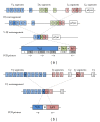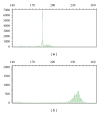The role of molecular pathology in the diagnosis of cutaneous lymphomas
- PMID: 23213624
- PMCID: PMC3506916
- DOI: 10.1155/2012/913523
The role of molecular pathology in the diagnosis of cutaneous lymphomas
Abstract
Primary cutaneous lymphomas can be difficult to be distinguished from reactive mimics, even when integrating histologic, immunophenotypic, and clinical findings. Molecular studies, especially PCR-based antigen receptor gene rearrangement (ARGR) analysis, are frequently useful ancillary studies in the evaluation of cutaneous lymphoproliferations. The biologic basis of ARGR studies is discussed, as well as a comparison of various current protocols. The pitfalls and limitations of ARGR analysis are also highlighted. Recent advances in the understanding of the molecular pathogenesis of various cutaneous lymphomas are discussed. Some of these nascent discoveries may lead to the development of diagnostically useful molecular assays.
Figures



References
-
- Swerdlow SH, Campo E, Harris NL, et al., editors. WHO Classification of Tumours of Haematopoietic and Lymphoid Tissue. 4th edition 2008.
-
- Olsen, Vonderheid E, Pimpinelli N, et al. Revisions to the staging and classification of mycosis fungoides and Sezary syndrome: a proposal of the International Society for Cutaneous Lymphomas (ISCL) and the cutaneous lymphoma task force of the European Organization of Research and Treatment of Cancer (EORTC) Blood. 2007;110(6):1713–1722. - PubMed
-
- Pimpinelli N, Oslen E, Santucci E, et al. Defining early mycosis fungoides. Journal of the American Academy of Dermatology. 2005;53(6):1053–1063. - PubMed
-
- van Dongen JJM, Wolvers-Tettero ILM. Analysis of immunoglobulin and T cell receptor genes. Part I: basic and technical aspects. Clinica Chimica Acta. 1991;198(1-2):1–91. - PubMed
LinkOut - more resources
Full Text Sources

